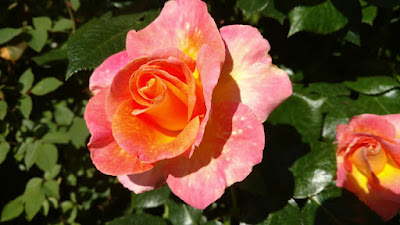
Lighter-colored blooms tend to cope better with triple-digit temperatures

|
| Neon-yellow Shockwave easily handles Sacramento summer heat. (Photos: Debbie Arrington) |
Some roses can take the heat better than others. I see proof of that all over my garden.
This heat wave has been a real test of rose fortitude under stressful conditions. Many bushes have sunburned leaves. Blooms on most of my hybrid teas are about half the size of normal; a cut back in irrigation during this drought-plagued summer is contributing to that issue.
But a few bushes have actually thrived during this high heat – and that prompted an in-depth discussion with Farmer Fred Hoffman for his “Beyond Basics: The Garden Basics with Farmer Fred Newsletter.”
That discussion became fodder for his latest post, “Roses That Can Take the Heat.”
“Sacramento (City Motto: “At Least It’s a Dry Heat”) is no stranger to prolonged, triple-digit heat waves, which can occur anytime from May through September,” Hoffman wrote in his introduction. “So, the area is a good testing ground for roses that maintain their color, health and vigor throughout spring, summer – and sometimes fall – heat waves. One trait many of these have in common: these rose bushes produce light-colored blooms of white, pink or yellow.”

|
|
The butter-yellow blooms of the Julia Child rose hold their
color in heat.
|
Lighter blooms tend to reflect that excess heat and stand up better to high temperatures. Of course, there are exceptions. (In this weather, Pink Promise, a light pink hybrid tea, immediately fades to dirty cream with brown edges.)
Which rose varieties stand up to the heat, keep blooming and looking great? Two yellow floribundas top my list: Julia Child and Shockwave. Most yellow roses tend to fade as they open, but both of these varieties hold their golden color. Julia Child has a more buttery hue (appropriate for its namesake) while Shockwave borders on neon. In addition to good color, both floribundas have beautiful, bright green, disease-resistant foliage that’s resistant to sunburn, too.
Among the best known heat-busting roses is Iceberg. This white floribunda fills parking lot borders throughout California; it can take pollution as well as high temperatures. It’s also drought tolerant, needing only weekly irrigation to keep blooming strong.

|
| Daybreaker has the colors of a sunrise. |
Landscape shrub roses such as the Drift series (Peach Drift, Apricot Drift, etc.) and Knockout roses (Double Knockout, Home Run, etc.) have built-in heat and drought tolerance. These roses stay short (under 2 to 3 feet) and are “self cleaning,” meaning they drop spent flowers as they age out; no deadheading necessary.
Of the big roses, First Prize – a neon-pink hybrid tea – has kept its bloom color all summer (although its foliage is showing some signs of sunburn).
Most of the miniature roses have done OK, mostly because the blooms and whole plants are smaller. They also benefit from a little shade from nearby bigger bushes. The best of the heat-busting minis is the appropriately named Joy, a spectacular little gem. Its cream-colored blooms are edged with bright purple-pink.
To listen to Fred’s podcast and read his newsletter: https://bit.ly/3wbUiRL .
Comments
0 comments have been posted.Sacramento Digs Gardening to your inbox.
Sites We Like
Garden Checklist for week of April 21
This week there’s plenty to keep gardeners busy. With no rain in the immediate forecast, remember to irrigate any new transplants.
* Weed, weed, weed! Get them before they flower and go to seed.
* April is the last chance to plant citrus trees such as dwarf orange, lemon and kumquat. These trees also look good in landscaping and provide fresh fruit in winter.
* Smell orange blossoms? Feed citrus trees with a low dose of balanced fertilizer (such as 10-10-10) during bloom to help set fruit. Keep an eye out for ants.
* Apply slow-release fertilizer to the lawn.
* Thoroughly clean debris from the bottom of outdoor ponds or fountains.
* Spring brings a flush of rapid growth, and that means your garden is really hungry. Feed shrubs and trees with a slow-release fertilizer. Or mulch with a 1-inch layer of compost.
* Azaleas and camellias looking a little yellow? If leaves are turning yellow between the veins, give them a boost with chelated iron.
* Trim dead flowers but not leaves from spring-flowering bulbs such as daffodils and tulips. Those leaves gather energy to create next year's flowers. Also, give the bulbs a fertilizer boost after bloom.
* Pinch chrysanthemums back to 12 inches for fall flowers. Cut old stems to the ground.
* Mulch around plants to conserve moisture and control weeds.
* From seed, plant beans, beets, cantaloupes, carrots, corn, cucumbers, melons, radishes and squash.
* Plant onion sets.
* In the flower garden, plant seeds for asters, cosmos, celosia, marigolds, salvia, sunflowers and zinnias.
* Transplant petunias, zinnias, geraniums and other summer bloomers.
* Plant perennials and dahlia tubers for summer bloom.
* Mid to late April is about the last chance to plant summer bulbs, such as gladiolus and tuberous begonias.
* Transplant lettuce seedlings. Choose varieties that mature quickly such as loose leaf.